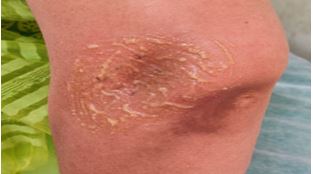Madhu Agnikarma in the pain management of Tennis Elbow - A Case Study
Keywords:
Madhu Agnikarma, tennis elbow, AnusastraAbstract
Lateral epicondylitis, also known as ‘tennis elbow’, is a very common condition that presents with pain and tenderness on the lateral side of the elbow due to the repetitive stress, results in inflammation of the common extensor tendon of the lateral epicondyle of the humerus. According to Ayurveda, Snayugata Vikara can be correlated with the condition of tennis elbow. Agnikarma being superior among all surgical and parasurgical procedure by its action seems to be more effective in providing instant pain relief. The therapeutic effects of Agnikarma with Kshoudra include relief of pain and muscle spasm, acceleration of healing, promotion of resolution of inflammation and increase in the range of movement of joint.
Downloads
References
Louis Solomon, David Warwick, Selvadurai Nayagam. Apley’s System of orthopaedics and fracture. 9th edition. London: Hodder Arnold; 2010. p.378.
Maheswari J, Mhaskar. Essential Orthopedics. 5thedition. New Delhi: Jaypee The Health sciences publisher; 2015. p.302.
Mahanta V, Dudhamal T S, Gupta S K. Management of Tennis Elbow by Agnikarma. Journal of Ayurveda and Integrative Medicine. 2013; 4(1):45-7. https://doi:10.4103/0975-9476.109552. s[accessed on 2021-7-03]
Acharya Trikamji Jadavji, editor. Susrutha, Susrutha samhitha, Nidanasthana, Ch-1, verse.25. Varanasi: Choukhamba Sanskrit Sansthan.2014. p.326.
Acharya Trikamji Jadavji, editor. Susrutha, Susrutha samhitha, Chikitsasthana, Ch-5, verse.52. Varanasi: Choukhamba Sanskrit Sansthan. 2014. p.428.
Acharya Trikamji Jadavji, editor. Susrutha, Susrutha samhitha, Suthrasthana, Ch-12, verse.4. Varanasi: Choukhamba Sanskrit Sansthan.2014. p.58.
Prasanth K S. A comparative study of agnikarma with Taptha Kshoudra and Panchaloha Shalaka in carpal tunnel syndrome: International Journal of Applied Ayurved Research. 2017Jul-Aug;3(3):677-83. http://ijaar.in/posts/images/upload/IJAAR_VOLUME_III__ISSUE_III_JUL_AUG_2017___677_683.pdf . [accessed on 2021-7-6]
Sharma Khemchand, Goyal Chinky, Prajapati Deepchand. Critical review on Madhu w.s.r. to honey. International Journal of Ayurveda and Pharma Research.2017;3(9):75-82. http://ijaar.in/posts/images/upload/IJAAR_VOLUME_III__ISSUE_III_JUL_AUG_2017___677_683.pdf. [accessed on 2021-7-6]
Haefeli M, Elfering A. Pain assessment. European Spine Journal. 2006;15(1): S17-24.
https://doi.org/10.1007/s00586-005-1044-x. [accessed on 2021-7-4]
Ronald LeFebvre. Tenderness Grading, Soft Tissue. University of Western States. 2014;1-2. https://www.academia.edu/35960258/TENDERNESS_GRADING_SOFT_TISSUE_Tenderness_Grading_Soft_Tissue. [accessed on 2021-7-6]
Niketh Narayanan T K. A Clinical study on the role of Agnikarma in the management of Tennis Elbow. 2011; 5(3): 23-9.
http://www.rguhs.ac.in/cdc/onlinecdc/uploads/03_A014_23570.doc. [accessed on 2021-7-3]
Das S. A manual on Clinical surgery. 12th Edition. Kolkata: S.Das; 2016. p.230.
Sreelatha K. Agnikarma Using Honey In Tennis Elbow. International Ayurvedic Medical Journal.2021.p.4-5.















